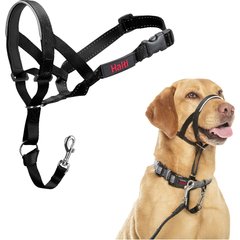Dog Walking Tips: How To Walk Your Dog
AsiaVision/E+ via Getty Images
Grabbing a leash and taking your dog for a walk seems like a very natural thing. But did you know that what you and how you act can influence the experience for your dog?
There are things that can be done to encourage your pooch to be better behaved when they’re on a leash, while making the experience even more fun for both of you.
Read on to find out all you need to know about walking your dog!
What Not To Do When Walking With Dogs
Just as you expect your dog to follow some rules of etiquette while you take them out to stretch their legs, there are some definite guidelines for us, as well.
Some of these are simply common sense—like not picking an area that is very crowded if you have an excitable dog or using a long retractable flexi-lead while in public.
You also don’t want to walk your dog on the traffic side of the road when sharing with cars, and you absolutely don’t want to allow your dog to leave waste on other’s property!
Also be considerate of others—don’t allow your dog to approach another animal without checking with the other pet parent first, and never let your dog jump on or walk up to strangers without asking for permission.
Let’s look at a few other things you shouldn’t do while walking a dog.
Using a Short Dog Leash
Walks offer a chance for dogs to stretch their legs, sniff out other neighborhood pups, and add their own signatures to the fence posts along the way.
A 6-foot leash is recommended for dog walking.
But, dogs need room in order to make their mark, and if you use a short dog leash, such as one under 3 feet, your dog won’t have much opportunity to roam.
A shorter leash also means that if your dog takes a few steps off the path to explore, he’ll end up pulling, which is a walking no-no. Leashes under 3 feet might be fine for a walk on a crowded city street, but if you want your dog to have an enjoyable stroll, give him more room to roam.
A 6-foot leash is recommended for dog walking. This allows your dog the space he needs while also considering his safety.
Recommended Products
Saying “No” To Sniffing
Our dogs experience a huge part of their world through scent.
Dogs use their noses to take in their environment much like we use our eyes, so requiring them to always walk without sniffing isn’t fair to them.
Hurrying your dog along during everyday walks denies them a major enrichment element that’s critical for canine happiness.
Plus, sniffing is a simple way to work your dog’s brain. A dog that’s allowed to sniff his way through a walk is likely to be more worn out at the end of it than a dog that didn’t have the opportunity.
Zoning Out During Your Walk
Sure, your daily stroll with your dog might seem like a great time to do some walking meditation, but there are a million reasons why you should stay engaged as you walk your dog.
Being mindful during walks enables you to keep your dog from picking up dangerous objects like trash and chicken bones, or from peeing on your neighbor’s prized plants.
Being aware during leash walks also helps with those unexpected moments, like when your dog lunges after a squirrel or gets too close to traffic.
Being engrossed in a conversation plus having only one hand available during a walk can be extremely dangerous. You’ll be even less prepared when that squirrel surprises you—your dog might be halfway down the street before you even realize what’s going on.
Staying tuned-in enables you to practice dog safety and react more quickly in high-pressure situations, which makes walks safer for you and your dog.
Talking on the Phone
This behavior takes the concept of zoning out to an even more dangerous level.
Being engrossed in a conversation plus having only one hand available during a walk can be extremely dangerous. You’ll be even less prepared when that squirrel surprises you—your dog might be halfway down the street before you even realize what’s going on.
Think going hands-free is a work-around?
Talking on a cell phone, hands-free or not, is still an impairment that divides your attention between your dog and your conversation. Your walks are an important bonding time with your dog, so why would you want to share that with anyone else?
Using Outdated Dog Walking Equipment
Long ago, painful choke collars were the only option for dealing with a dog that pulls on leash. Thankfully, anti-pull technology has come a long way since then!
Many vets recommend no-pull devices like Halti® collars instead of choke collars or harnesses. This type of collar will gently discourage pulling—pet parents should never use pain to train.
Recommended Products
Walking the Same Route
Variety is the spice of walks, but many pet parents stick to the same well-travelled path whenever they venture out. While your dog probably appreciates every walk you take, dogs get even more of a thrill checking out the sights in different parts of the neighborhood.
However, that doesn’t mean that you must take your dog on faraway journeys every time you head out the door.
Sometimes walking dogs on a parallel street is enough of a change of pace, or even reversing the direction of your walk and starting off your journey where you usually end up.
Our dogs don’t ask much of us in return for their endless affection, so the least we can do for them is give them room to safely sniff, roam and explore during daily walks.
Tuning in to your dog instead of your phone while you stroll and taking the road less traveled are fantastic ways to grow your bond.
It’s not hard to add enrichment to your dog’s walks, and once you do, he’ll thank you for it! Keep these dog walking tips in mind on your next walk for a truly engaged bonding experience.
How To Walk a Dog the Right Way
In all reality, the “right way” to walk a dog is when both you and your pup return home at the end of the walk satisfied and happy.
However, there are some guidelines which can help make the experience safer and more enjoyable for all. A few dog walking tips include:
-
Walk your dog in a safe area without too much excitement where you can easily watch for dangers and distractions. Use a reasonably short leash (no more than 6 feet) and a collar system that allows you to prevent your dog from pulling or jumping on other people or animals.
-
Intermix walks for exercise and exploring. For exercise walks, the focus may be on speed and distance, and less on sniffing or roaming. Exploring walks might include an adventure into a different area, or more time to smell the details of the neighborhood.
-
Remember that other people may not love your dog as much as you do, and that other animals may not be as friendly as your pup. Always keep your dog under control and do not allow them to approach others without invitation. Be sure to clean up any waste immediately.
-
Make sure you're prepared for dog walking in any type of weather—such as the warmer weather and colder weather.
Recommended Products
-
Enjoy your time with your dog! Resist the temptation to multi-task and send texts, talk on the phone, or be distracted.
Although there aren’t any hard and fast rules about walking your dog, at the end of the day, you should be getting back home again with a content and tired pooch!



